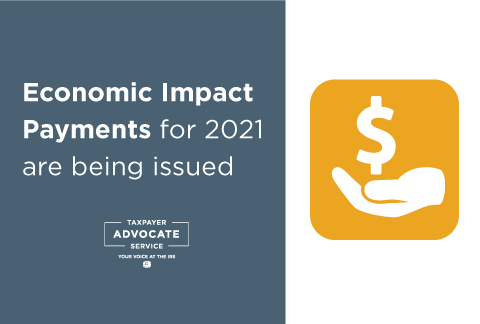The Taxpayer Advocate Service (TAS) is receiving a lot of inquiries and submissions through the Systemic Advocacy Management System (SAMS) (a portal for reporting systemic issues impacting groups of taxpayers) about the third round of stimulus payments, also known as Economic Impact Payments (EIP3). Taxpayers should not call, submit a hardship request or submit a systemic problem report for these payments.
The IRS is issuing EIP3 amounts automatically to taxpayers who are eligible. The IRS will use available information to determine your eligibility and issue the third payment to eligible people who:
- filed a 2020 tax return,
- filed a 2019 tax return if the 2020 tax return has not been submitted or processed yet,
- did not file a 2020 or 2019 tax return but registered for the first Economic Impact Payment with the Non-Filers tool on www.irs.gov in 2020, or
- are federal benefit recipients who do not usually file a tax return.
Further, the IRS is sending additional or “plus-up” payments to people who:
- Already received EIP3 based on a 2019 tax return or information received from the Social Security Administration, the Railroad Retirement Board, or Veterans Affairs, or
- May be eligible for a plus-up payment based on their 2020 tax return.
These payments started in March and will continue this year, weekly, as more 2020 tax returns get processed. There is no specific timeframe under the law that these payments must be issued during 2021.
- You cannot call and request that the EIP3 be issued to you. This is applicable even for taxpayers experiencing financial hardship situations.
- You will not get one quicker by trying to report the issuance delay as a systemic issue. It is not a systemic error. Doing this only causes critical TAS resources to be diverted from helping other taxpayers needing assistance with qualified cases that meet TAS criteria.
To Check on Your Third Economic Impact Payment (EIP3) Status:
- Use the IRS’s tool, Get My Payment, to find the status of your third payment or “plus-up” payment.
- Monitor the IRS News page for weekly updates on EIP3.
EIP3 Information
- The EIP3 is not claimed on your 2020 tax return or used to calculate the 2020 Recovery Rebate Credit.
- If you do not receive an EIP3, the only way to get one is to claim it on your 2021 Individual tax return when you file next year. This is because the EIP3 is as an advance payment of the tax year 2021 Recovery Rebate Credit.
- Shortly after the EIP3 is issued, you will receive an IRS Notice 1444-C. Keep this letter with your tax year 2021 records.
- If you were issued an EIP3, but did not receive it, see Payment Issued but Lost, Stolen, Destroyed or Not Received.
- More information about when EIP3 amounts were made to federal beneficiaries who do not normally file a tax return was provided in the March 30 news release and the April 14 news release.
More information about the EIP3
For even more information about the EIP3 and claiming the Recovery Rebate Credit in 2021, see these IRS and TAS webpages and products:
TAS
IRS
- Third Economic Impact Payment English | Spanish │ Chinese-Simplified │Chinese-Traditional │ Korean | Russian │ Vietnamese | Haitian Creole
- Questions and Answers about the Third Economic Impact Payment
- Get My Payment
- Get My Payment Frequently Asked Questions
- FS-2021-06, April 2021, IRS information letters about Economic Impact Payments and the Recovery Rebate Credit
- IR-2021-69, March 30, 2021, IRS projects stimulus payments to non-filer Social Security and other federal beneficiaries will be disbursed later this week
- IR-2021-62, More Economic Impact Payments set for disbursement in coming days; taxpayers should watch mail for paper checks, debit cards
- FS-2021-05, Updated details about the third round of Economic Impact Payments
- IR-2021-54, IRS begins delivering third round of Economic Impact Payments to Americans
- FS-2021-04, More details about the third round of Economic Impact Payments
- People experiencing homelessness can get Economic Impact Payments and other tax benefits English │ Spanish
- You don’t need a permanent address or bank account to get an Economic Impact Payment English | Spanish
- How to get an Economic Impact Payment if you don’t have a bank account English | Spanish

